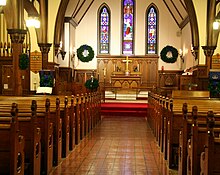



The parish of Christ Episcopal Church in Red Wing, Minnesota, United States, was founded in 1858. A wooden building was erected that served the early parish well, but by 1868 it was felt that the growth of the parish made the building of a larger church a necessity.
In the autumn of that year work began on the new building, constructed in Gothic Revival style following plans furnished by New York architect Henry C. Dudley.
- D.C. Hill was contracted to do the basic carpentry work; George H. Davis provided the finished carpentry (seats, columns, tracery, wainscoting; all of butternut finished in oil).
- G.A. Carlson carried out the stonework with magnesian limestone from his quarries.
- The windows were furnished by a "Mr. Sharpe from New York."
The cornerstone was laid June 24, 1869 and the new church was consecrated by Bishop Henry Benjamin Whipple on December 19, 1871. (Due to concerns about the foundations, the steeple was not added until 1897.)
The church is now a contributing property to the Red Wing Mall Historic District, which is listed on the National Register of Historic Places.
References
- A History of Goodhue County; Wood, Alley & Co, Red Wing, 1878; 369. In 1863 Draper & Dudley had been the architects of a new building for St. Paul's Episcopal Church in Waterloo, NY. Waterloo was the boyhood home of the Rev. Edward R. Welles, founding rector of Christ Church (1858-1874), and the Welles family was prominently engaged in the building of the new St. Paul's. (See A History of Seneca County; Everts, Ensign and Everts, Philadelphia, 1878; 88.) While providing essentially the same elevation as St. Paul's, for Christ Church Dudley reversed the placement of the tower from the right to left sides of the façade.
- A History of Goodhue County; Wood, Alley & Co, Red Wing, 1878. Possibly Henry E. Sharp, who was active in New York between c. 1850 and 1897 and who furnished glass for a number of Gothic Revival churches. (See Alice Cooney Freylinghuysen, American Stained Glass in a New Light; http://www.antiquesandfineart.com/articles/ article.cfm?request=959; accessed April 4, 2011.) Sharp's ad in The Churchman of roughly the same time period features "stained glass windows for churches; memorial windows a specialty." (The Churchman, Vol. 36, Nov. 10, 1877; Churchman Co., New York; 532.) In 1863 Sharp also provided glass for St. John's Chapel, Hobart College, which had been Welles' alma mater some years earlier. (Lewis Cass Aldritch and George Stillwell Conner, A History of Ontario County, NY; D. Mason and Co., Syracuse, NY,1893; 291.)
- A History of Christ Church; parish production for the 150th anniversary, 2008; 7.
- A History of Christ Church; parish production for the 150th anniversary, 2008; 9.
External links
- [REDACTED] Media related to Christ Episcopal Church (Red Wing, Minnesota) at Wikimedia Commons
- Christ Episcopal Church (Red Wing, MN)
44°33′49″N 92°32′7.7″W / 44.56361°N 92.535472°W / 44.56361; -92.535472
Categories: